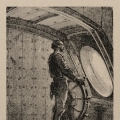Interference fit pressure comparison MECWAY/CALCULIX & ANSYS.
Hello,
I have reproduced a study case from ANSYS forum to help me better understand how contact works.
Seems ANSYS can automatically adjust Contact Stiffness to reach a desired Contact Clearance. I have done it manually to be

I have reproduced a study case from ANSYS forum to help me better understand how contact works.
Seems ANSYS can automatically adjust Contact Stiffness to reach a desired Contact Clearance. I have done it manually to be

Howdy, Stranger!
It looks like you're new here. If you want to get involved, click one of these buttons!


Comments
Seems ANSYS can automatically adjust Contact Stiffness to reach a desired Contact Clearance. I have done it manually to be <than 10-6.
All the details in https://forum.ansys.com/discussion/8101/interference-fit-pressure
Results between theory (308.11 MPa) , ANSYS and MECWAY/CCX are almost the same.
I post the study file in case someone is interested, wants to comment or finds something wrong or missing.
Edited. Added file below 1000 nodes
Press fits definitely require high contact stiffness, because penetration error directly reduces the interference, which is usually a small number to begin with. So if your penetration is 0.001 and the interference is 0.01, that's a 10% error.
For other contact stiffness, such as a cam/follower combination with larger motions, you can tolerate more penetration and the error will be negligible. This is important, as overly stiff contact pairs will increase convergence time.
I think these two have some good reference data:
I reproduced those two video tutorials some days ago. My post is the direct application of the first one with “real world numbers” to check its performance.
The reason for displacement functions is that if you find a way to impose the BC directly on the nodes (not on the surface), the convergence and matrix assemblies seems much faster and stable. It could also be made by means of the *Transform Card Sergio show me some days ago. There is an example in the “Radial stiffness of PreCalibrated Bushings “ post.
I’m still working on the second video as it’s juicier. I 'm searching a way to activate and deactivate contacts in the middle of a Nonlinear process.
I will open a new Post as it could be a useful procedure to someone else.
I will call it "MODEL CHANGE- CONTACT PAIR, REMOVE/ADD"
As a continuation of the previous example, I have completed another test in which I reviewed the response of the friction parameter in the contact BC.
It performs very well, and the pressed plate has shown to slip/release at the expected value.
The only thing I guess I would like to improve is how to get the initial contact pressure more precisely.
Young’s modulus of the materials are playing a rol themselves in the initial set up of the contact.
Desired Contact compression Force (2.000N) vs Obtained compression Force (1.939N)
It would be interesting if someone finds a way to adjust that small difference.
The block has start to slip at 21.789º. (Expected 21.801º)
Not easy but it's worth the effort. It’s good to confirm the different tools work properly and understand their limitations.
I have found that Contact can be slightly sticky so it’s not a good idea to abuse of the Stiffness parameter.
I think the proper approach is to start low and increase up to the point convergence is attained. Then, check clearance reach the desired value.